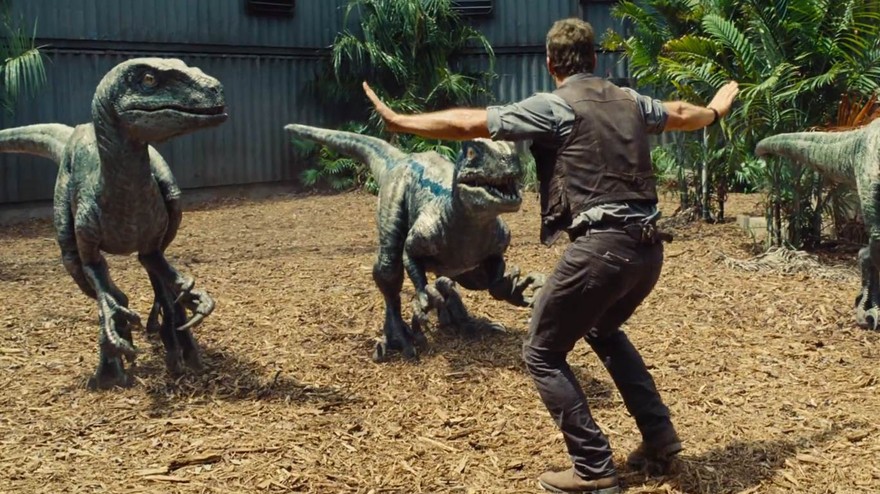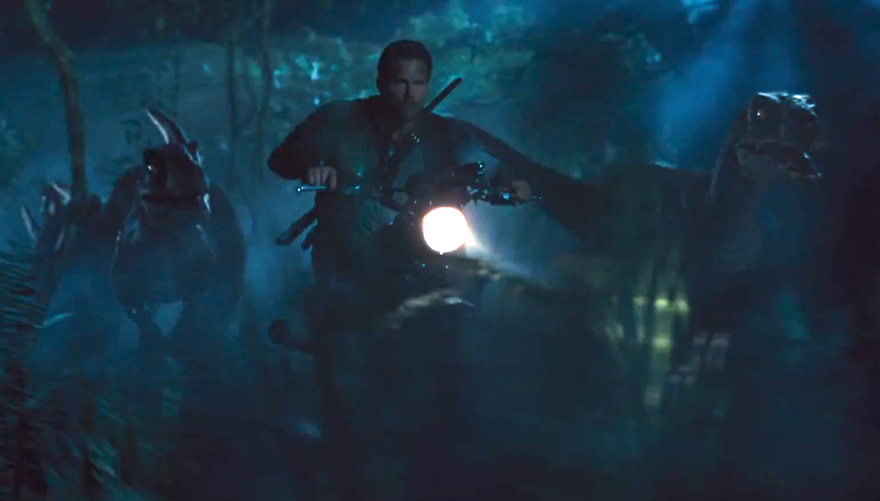There is a scene late in Jurassic World that someone in the PR team leaned pretty hard on. You know the one; I’ve been staring at a subway poster still of it every day of my commute for the last month. In pursuit of the toothy villain, Chris Pratt rides a motorcycle through the Costa Rican jungle at night, flanked by a pack of Velociraptors. His Velociraptors, to be precise—he is, as he quips earlier, their alpha. Vincent D’onofrio, playing a military-industrialist dumbo named Hoskins, leans into his camera feed and utters his one relatable line in the film: “Awesome.”

And he’s right: it is awesome. It’s a poor idea from the start, releasing dangerous dinosaurs to hunt another dangerous dinosaur. It’s absurd both within the context of the film and outside of that context, but, all at once, that doesn’t matter: for one, shining, glorious moment, it is the coolest thing you have ever seen. The twelve-year-old inside you stirs, blinks, rises to the forefront. The raptors bob and weave through the foliage, calling to each other in their extremely familiar clicks, illuminated occasionally by the headlamp of Pratt’s Triumph. Oh my god, Vincent D’onofrio is right: it is awesome.
Things go south pretty shortly after that, as they tend to on Isla Nublar. But you will always have that moment.
Jurassic World is, like its siblings, a story of wonder and folly. Replacing Tim and Lex, the child-heroes of the first film, are brothers Gray and Zach, who have been packed off by their domestically troubled parents in the most dangerous divorce power move in history. Gray, the younger, is struck with wild joy at getting to watch dinosaurs eat unfortunate not-dinosaurs, while Zach is a sulky teenager who spends more time staring at girls than the prehistoric beasts. You don’t need to know any more about those two. The film employs them as a tour guide, essentially—director Colin Trevorrow knows we want to see the park, and Zach and Gray give us that opportunity. As soon as that’s done with, the movie shunts them to the side to focus on the more three-dimensional characters: the raptors.
I want to say that again, so you don’t think I’m joking—the raptors of Jurassic World are the best developed characters in the film. They have a more dramatic arc than the kids; they face more difficult decisions than Pratt, who plays their vest-wearing, stubble-having trainer. Many have accused Trevorrow of declawing the raptors and turning them into pets, but they’re still clearly dangerous creatures: early on, after finding himself in the raptor pen, they nearly rip Pratt to pieces. Recall that the tiger who mauled Roy Horn of “Siegfried and Roy,” ending his stage career, had performed 2000 times prior to the attack with no issue.
The central misstep of the movie, ironically, is also the bad decision from which Jurassic World‘s main conflict springs. To combat flagging audience numbers, InGen creates the predatory equivalent of the world’s tallest roller coaster: a big spiky dino made from a classified cocktail of genes and dubbed the Indominus Rex. She escapes, to the surprise of not one goddamn person. It’s a plot befitting a Syfy channel original movie, not the inheritor of a legacy built on Crichton’s science-driven thrillers.

Across the run-time of Jurassic World, moments of wonder and terribleness abound. Look, it’s a toddler riding a baby triceratops! Amazing. A man screaming “active camouflage” shortly before being eaten? Well, that’s pretty dumb. A raptor being thrown through plate glass into a gift shop? Amazing again! Familiar babble about mankind meddling with forces better left alone? Less amazing. Of course, we expect some variability in our summer blockbusters. Where Jurassic World stands out is that, often, its dumbest moments are also its finest and best, like the raptor motorcycle scene. The ending, which common decency prevents me from spoiling, is another such moment. My audience, a Monday night after-work crowd, cheered and applauded. It was dumb, and it was amazing. This ebb and flow between the silly and the sublime has always been the appeal of the Jurassic Park series.
I don’t mean to suggest that I enjoyed the film ironically, as most people do when they describe films “so bad they’re great.” I mean that I was confronted with a kind of paradox; I recognized the absurdity of what I was watching, but could not fail to love it. I was in an existential crisis, watching these dinosaurs stomp through a fictionalized Six Flags.
But perhaps I just need a larger lens. Kierkegaard describes faith in terms of the absurd: “When the believer has faith, the absurd is not the absurd—faith transforms it, but in every weak moment it is again more or less absurd to him.” By the absurd, Kierkegaard is referring to his belief in a Christian God. I, on the other hand, use it here to mean Chris Pratt racing his raptor pack through the Costa Rican jungle.
It is a dumb scene. It is a bad scene. But, through not faith but child-like wonder, it was transformed for me—and for everyone else in the theater—into something transcendent. Something awesome.
